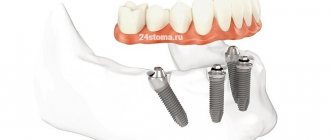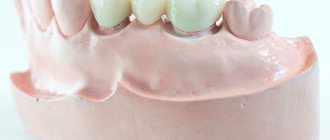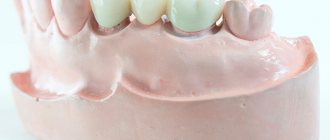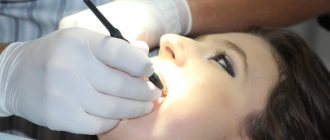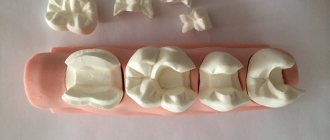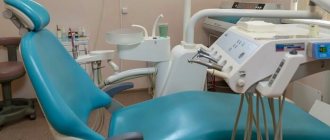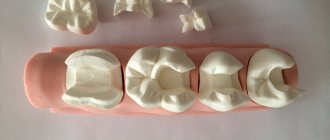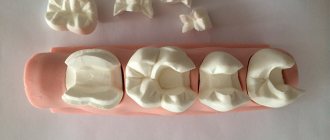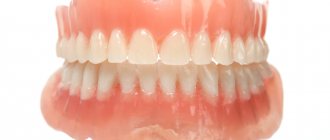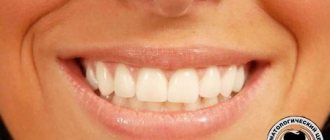From this article you will learn:
- how to improve the fixation of complete removable dentures,
- types of overdentures, reviews,
- price for 2022.
Conditionally removable (covering) dentures are a type of dental prosthetics in the complete absence of teeth, when several dental implants are installed under a removable denture in order to improve its fixation on a toothless jaw. Fixation of such prostheses to implants installed in the bone tissue of the jaws is carried out using special locking fasteners. Such attachments can be push-button or bar-type, for example, through ball-shaped abutments, Locator® equatorial abutments, and cast or milled bars (Fig. 1-3).
Dentures of this type are called “conditionally removable” in dentistry for the reason that you can only remove such a denture if you apply sufficient force. However, patients more often call them by the term “overdentures”. Their biggest advantage is that they never fall off while talking or chewing. It should also be noted that dentures of this type can be used not only with complete, but also sometimes with partial absence of teeth.
Conditionally removable prosthesis: photo
* The minimum cost of a conditionally removable prosthesis on implants will start from 100,000 rubles (detailed options for prostheses and prices - see below).
Advantages of conditionally removable dentures –
Traditional removable dentures made of ordinary acrylic plastic are very poorly fixed on toothless jaws. This is due to the fact that under removable dentures, atrophy of the alveolar processes of the jaws (on which the denture “sits”) gradually occurs. This leads to a gradual decrease in the height and width of the alveolar processes - in proportion to this, the fixation of the prosthesis worsens.
Advantages of dentures on implants -
- excellent fixation even with severe bone atrophy,
- immediate prosthetics,
- comfort - such dentures have a smaller plastic base (on the upper jaw the denture is made with virtually no overlap of the palate),
- relatively affordable price.
What is implant prosthetics?
There are many methods for restoring teeth in dentistry.
Each of them has its advantages and helps solve a specific problem. However, implant prosthetics are considered the most effective. The basis of the method is the implantation of titanium pins into the jawbone, which replace the roots of natural teeth. An orthopedic structure is installed on top of the pin, depending on the condition of the dentition.
The technology is applicable to restore one tooth, several dental units in a row, or the entire jaw at once. In the first case, an artificial crown is fixed on the implant, a bridge structure is used to replace 2-3 teeth, and when all teeth are restored, a fixed or removable prosthesis is used. The doctor selects the material for the orthopedic design based on the method of installing the prosthesis, the preferences and financial capabilities of the patient.
Types of prosthetics:
- Classic dental implantation. Suitable for cases where 1-2 teeth from a row are missing. Can be with delayed or immediate loading, with installation in one or more stages.
- All teeth in 1 day. It is used in cases of complete edentia (loss of teeth). Offers several solutions, depending on the structure of the jaw and the condition of the bone tissue. This can be the installation of All-on-4, All-on-6 protocols or simultaneous implantation.
Swiss implants of the Oneway Biomed brand (Uanway Biomed)
Oneway Biomed is a well-known brand of implants that have been produced for over 20 years. The corporation is headed by the authoritative Dr. Ide, who is one of the authors of the now popular basal implantation technology. The company produces implants for classic 2-stage, 1-stage implantation, but still relies on immediate loading with systems. In the Oneway Biomed line, you can select Swiss implants for placement at an angle or vertically in the bone tissue.
Competitive features of Oneway Biomed implants (Switzerland):
- The implants are made of the purest high-quality titanium alloy Ti-6Al-4V ELI (Grade 5);
- The brand’s line includes more than 350 modifications of dental implants, allowing the restoration of single teeth or a whole series (for example, with complete edentia);
- High-precision positioning of the implant in the bone. Treatment can be carried out using 3D modeling technology;
- Due to the self-tapping thread, the implant is screwed into the bone with minimal trauma, but with a tight fit and stable positioning of the implant;
- Ideal engraftment of the Swiss implant into the bone is achieved by sandblasting the titanium surface, as well as etching the metal with acid. This significantly improves the process of osseointegration of the implant.
The approximate price of one Swiss Oneway Biomed implant is 30,500 rubles per unit.
Pros of technology
Some will say that dental implantation is very expensive. But if you evaluate the result in perspective, it turns out that this is a profitable investment in your own health for the next 20-25 years.
Judge for yourself: the service life of prostheses on implants is 2-3 times longer than traditional designs. And the titanium pin ensures an even load on the jaw, while maintaining chewing and speech functions.
In addition, the use of implants when installing dentures allows you to restore any number of teeth, regardless of their location in the oral cavity.
In case of edentia (complete absence of teeth), implants can be used to place not only a removable, but also a permanent orthopedic structure, which in its properties is much more convenient and reliable.
An even load on the upper and lower jaw eliminates bone tissue atrophy and subsequent problems with natural teeth. In addition, implant prosthetics do not use healthy teeth. Nothing is attached to them; natural teeth do not need to be ground down, which significantly extends their life.
Dentures are comfortable to wear: they do not injure the gums, do not distort diction, and do not shift under load.
But the main advantage is the high level of aesthetics. All types of dentures installed on implants look like real teeth.
Producing countries - which are the best?
The price range is divided into 3 categories - premium, medium, economy. Categories are distributed by country and manufacturer. Prices for implants of different brands within the country are approximately the same, since manufacturers compete within the same state and try to be competitive in price and quality.
Manufacturing countries of implantation systems by price category:
- Premium - Switzerland, USA, Sweden, Germany.
- Middle - South Korea, Israel.
- Economy - Russia, Belarus.
The classification determines the quality and cost of implants in different countries, but it is rather arbitrary. For example, in Sweden and Germany both premium systems and mid-segment implants are produced.
Types of prostheses on implants
In general, implant-supported prostheses are divided into two types:
- Removable.
- Fixed.
The first type differs significantly from analogues of classical prosthetics. Traditional structures are fixed exclusively on the gums, or attached to supporting teeth. Thanks to implants, removable dentures are securely fixed in the jawbone, but they can be removed if necessary. That's why they are called conditionally removable.
Fixed dentures are considered a more durable and optimal option for dental restoration. In addition to the artificial crown, some types of structures are equipped with a base made of elastic plastic, which imitates natural gums.
Fixed dentures can be used to replace any number of teeth, even if they are located in different parts of the dentition. We will talk in more detail about each type of prosthesis a little later.
There are also temporary dentures that are installed during the period of fusion of the implants with the jawbone. They maintain the aesthetics of the dentition and reduce the mechanical load on the pins, speeding up the healing process.
Temporary dentures look like removable structures that hook onto supporting healthy teeth using hooks. The most common option is a butterfly-shaped prosthesis. It is equipped with a plastic gum and two plastic holders for adjacent teeth. A denture replaces one or more teeth in a row.
Swiss implants from the SGS Dental System brand
The Swiss brand SGS Dental System has been producing implants since 2007. The brand is considered one of the youngest on the market, but its implants are extremely popular due to their affordable price. SGS Dental System dental implants are represented in almost 150 countries around the world. The company's slogan: high quality for a reasonable price.
SGS Dental System's production facilities are located in Hungary and Germany. The implants themselves are manufactured in Hungarian factories, but the coating and final quality control of the systems are carried out in laboratories in Germany.
The main types of dental implants SGS Dental System:
- P7S and P9S are one-component implants (the body of the implant is connected to the abutment), which are recommended for simultaneous loading. These types of systems differ in the thickness of the base;
- Premium P1 – screw dental implants with double thread (often called aggressive by dentists). Such systems are considered universal from the point of view of restoring the chewing group or incisors;
- Premium P7 is a conical implant with decent primary stability.
The main nuance of SGS Dental System implants is their relative youth. Many dentists prefer to install implants from more well-known brands that have undergone a lot of research and clinical tests.
The average price of one Swiss SGS Dental System implant is 23,500 rubles per unit.
Installation steps
The reliability of implant-supported dentures directly depends on the location of fixation. Especially when it comes to restoring all teeth. Correct placement of implants will ensure uniform distribution of chewing load on the jaw and allow the use of a minimum number of pins. This reduces the recovery period and the degree of surgical intervention during installation.
At the initial stage, the implantologist performs an initial examination of the oral cavity. In EspaDent clinics, to select a prosthetic method, additional diagnostics are carried out using a modern Orthophos SL 3D tomograph, which takes three-dimensional, layer-by-layer images of both jaws. Professional equipment allows you to simulate the treatment process and show the patient the final result.
In the absence of contraindications, the doctor proceeds to the next stage of prosthetics on implants - fixation of titanium pins in the jawbone. The procedure takes 40-60 minutes for each implant. It is carried out using anesthesia. Our specialists use safe painkillers. They are non-toxic and do not cause allergic reactions.
The pin fixation process includes:
- Gum section.
- Preparing the space in the jawbone.
- Implant installation.
- Gum stitching.
The period of fusion of the pin with the bone tissue takes 3-4 months. During this time, the patient is fitted with temporary removable dentures, which we discussed above.
After the healing process is completed, the doctor installs a gum former and takes an impression of the teeth. After a couple of days, the adapter is replaced with an abutment, on which the finished denture is fixed.
How long does implant prosthetics take?
The duration of installation of prostheses on implants depends on the clinical situation. After performing a tomography of the jaw, the doctor assesses the condition of the bone tissue. Depending on the degree of jawbone atrophy, the implantologist may prescribe an osteoplasty procedure.
The period of prosthetics on implants is determined by the rate of bone tissue regeneration, as well as the chosen installation technique. For example, the healing period of implants in the upper jaw takes, on average, 3-4 months. For the lower jaw a little less - 2-3 months.
If a procedure is carried out to restore bone tissue due to atrophy, then another 2-4 weeks are added to the installation of prostheses.
Covering denture: price 2022
How much does a covering prosthesis cost? The prices below are indicated on a turnkey basis for 2022 (in economy-class and mid-price clinics). The price of the prosthesis will primarily depend on the type of fixation, as well as the number of implants installed.
- Prosthesis on 4 mini-implants Osstem (Korea) with fixation on spherical abutments - the price will be from 100,000 rubles.
- Prosthesis on 2 MIS implants (Israel) with fixation on ball-shaped abutments - price from 110,000 rubles.
- Prosthesis on 2 AstraTech implants (Sweden) with fixation system Locator® – from 140,000 rubles.
- Prosthesis on 2 Straumann implants (Switzerland) with Locator® system fixation – price from 160,000 rubles.
Prosthetics using removable structures
When is it advisable to use removable dentures on implants? Often the argument is limited budget. Removable structures are much cheaper than permanent ones, especially in the case of complete edentia.
The method is effective for severe atrophy of the jaw bone, if the patient is not ready to undergo a sinus lift of the jaw. A denture with artificial gum will hide imperfections in the contour of your own tissues.
Conditionally removable structures are fixed to implants in two ways: screw or beam. In the second case, a metal structure in the form of a beam is used, on which artificial teeth are installed. The beam serves as the base of the prosthesis and ensures uniform distribution of mechanical load on the bone. Due to the single design, the prosthesis is more stable.
Both options for fixing the prosthesis can be removed if necessary (for cleaning, etc.). However, only a dentist should do this.
What is the difference between classic removable dentures and those installed on implants? The design with pins is smaller in size and has better fixation in the oral cavity, which ensures comfortable wearing.
The absence of a palate in the prosthesis preserves taste sensitivity when eating food, without any restrictions.
The ability to remove the prosthesis extends its service life and allows for timely cleaning and replacement of elements, if necessary.
Lower cost makes this type of implant prosthetics accessible to most patients.
If we talk about size, fixed dentures are more neat and compact. From an aesthetic point of view, removable ones are also inferior to non-removable ones. The latter do not have artificial gums.
To make crowns in removable dentures, the following is used:
- Plastic (for temporary fixation).
- Ceramics.
- Zirconium dioxide.
All materials have increased strength and high aesthetics. At EspaDent clinics, crowns are made using digital CAD/CAM technology. The automatic production mode eliminates the occurrence of errors associated with the human factor. Dentures take into account the anatomical structure of the patient’s jaw and the location of adjacent teeth. Their installation does not change the bite, does not deform the masticatory muscles, and does not cause facial asymmetry.
Prices
| Service | Price |
| Temporary plastic crown for implant | from 4,900 rub. |
| Metal-ceramic crown on an implant | from 17,500 rub. |
| Metal-free crown on an implant | from 23,100 rub. |
| Implant crown based on zirconium dioxide | from 28,100 rub. |
To avoid possible misunderstandings, please clarify the cost of services in clinics with the administrator or during a consultation with a doctor. Prices on the website are not a public offer.
Sign up for a consultation
Fixed structures
As a rule, crowns or bridges are used for permanent dental prosthetics on implants. A single denture most accurately replicates the shape and appearance of the missing tooth. Using single crowns, the implantologist corrects the gum contour, making it almost ideal. This is especially true for the front teeth that fall into the smile zone.
A bridge structure is used to restore several teeth. It is necessary in cases where it is not possible to install 2-3 implants in a row due to lack of space.
The difference from a traditional bridge lies in the method of fastening. The structure receives additional support in the form of pins and does not affect adjacent healthy teeth. In other words, there is no need to grind down your natural teeth and attach a prosthesis to them.
The advantages of the technique include the maximum degree of stabilization of the prosthesis, high aesthetics and a tight fit of the structure to the gum, which eliminates its damage and the ingress of food debris into the prosthesis.
The only disadvantage of fixed dentures on implants is the price. But in fact, this is the most profitable investment in your own health. The durability of the implants and the lifetime guarantee for their installation only confirms the quality of the technique.
Comparison by survival rate, price and warranty period
| Brand | Survival rate | Osseointegration | Guarantee | Price |
| Nobel Biocare | 99,9% | the best | lifelong | premium |
| Astra Tech | 99,6% | the best | lifelong | premium |
| Straumann | 99,6% | the best | lifelong | premium |
| Xive Ankylos | 99% | accelerated | lifelong | average |
| Impro | 98% | accelerated | lifelong | average |
| Biohorizons | 97,3% | regular | lifelong | average |
| Alpha Bio | 97,2% | regular | lifelong | economy |
| Osstem | 97% | accelerated | lifelong | economy |
| Dentium | 97% | regular | from 20 years to life | economy |
Premium implants have survival rates close to 100%, short periods of osseointegration, and are guaranteed for life. But the service life of implants is also influenced by the level of training of the doctor, the clinical situation, and the patient’s oral care literacy. A person must trust the doctor and follow the recommendations he gives.
Restoration of teeth with complete edentia
The method of fixed prosthetics effectively copes with the problem of complete absence of teeth. For example, All-on-4, All-on-6 protocols or simultaneous implantation.
The All-on-4 protocol involves the installation of four implants in the jaw: two in the frontal part, two on the sides, at an angle of 45 degrees.
The technology provides instant chewing load, immediately after fixing the prosthesis. Installation of the prosthesis is possible immediately after implantation.
If the patient has severe jawbone atrophy, the All-on-6 protocol is used. An additional number of implants ensures reliable fixation of the prosthesis even with insufficient bone tissue.
But be careful! Due to the popularity of the technology, many fakes have appeared. Poor quality materials and unprofessional work can lead to serious health complications and loss of money.
EspaDent is an official partner of Nobel Biocare, a leader in implantology and developer of protocols for dental restoration in 1 day.
In 2016, with the support of Nobel Biocare, our clinic created its own Center for implantation and complete dental prosthetics, which provides training to specialists from all regions of Russia.
Swiss implants Roott
Classic Swiss Root implants are also in great demand. The company is known for its innovative development of implants for basal implantation. Roott produces products that are screwed into the deep layers of bone, eliminating the need for additional bone augmentation. This implantation format is suitable for people with jaw bone problems, smokers, and patients with diabetes.
TOP 4 series of Root implants (Switzerland):
- Compressive are Swiss compression implants in which the abutment is connected to the main metal rod. Such implants are suitable for implantation immediately after tooth extraction, which eliminates the need for a sinus lift;
- Basal are classic basal Swiss implants that are screwed into the deepest layers of bone. These implants are quite thin, long, but at the same time durable;
- Form – traditional Swiss implants from the Root brand in the shape of a natural root. They are quite versatile and therefore suitable for restoring chewing teeth and incisors.
- Compressive-K – combines the classic characteristics of Form and Basal implants. The implants take root well, including in the soft bone of the upper jaw.
The estimated cost of one Root implant is 29,000 rubles per unit, and a turnkey tooth restoration with the installation of a metal-ceramic crown will cost about 40,500 rubles.
Materials for dentures
To attach prostheses to implants, the material must be highly durable or have a metal base. This is necessary for the structure to withstand the load of the abutment (adapter).
Crowns for fixed structures are made from metal-ceramics, composite, metal-plastic, and also from zirconium dioxide. The prosthesis is attached using cement or screws.
Composite crowns for implants with a metal frame are used for single replacements, as well as for the installation of bridges. The design has a long service life (10-12 years) and is subject to repair. Reliable, lightweight, with a high degree of aesthetics, composite crowns are comfortable to wear and look like real teeth.
Plastic removable dentures last no more than 5 years and are used only for temporary or adaptive prosthetics. At EspaDent clinics, our specialists use more technologically advanced plastic for temporary prostheses. The composition contains crushed diamond chips, which makes the structure more resistant to stress during the fusion of the implant with the bone.
Fixed prosthesis is made of zirconium or metal ceramics. This is due to the high reliability of the design. Crowns for implants cannot be restored, as is the case with composite ones, so they must be as strong and durable as possible. For metal-ceramics, the service life is 8-10 years, and zirconium is a little longer - 15-17 years.
The disadvantages include the imperfect aesthetics of ceramic crowns - the metal base can be visible in the light. Therefore, it is better to use them to restore lateral teeth.
Zirconium dioxide crowns have almost no disadvantages. Decent service life, impeccable appearance, increased material strength, absence of allergic reactions even in patients with high sensitivity. Of course, such prostheses are more expensive than their analogues.
Maintenance and care of the prosthesis –
Permanent dentures All-on-4 require a very careful attitude. If you previously had a regular removable denture and cleaning it from plaque and food debris was quite simple, now your time spent on hygiene will immediately increase several times. Unfortunately, this comes at a price for the opportunity to have completely permanent dentures. The biggest difficulty is cleaning the underside of the denture.
A fixed denture does not “lie” on the gums, and between the gum and the lower surface of the denture there will be a rinsing space - where food debris will certainly fall. And, accordingly, with insufficient hygiene, plaque and tartar will be deposited on the lower surface of the denture. To prevent this, it will be necessary to regularly use an oral irrigator, as well as use special super-flosses. In addition, regular cleaning of the denture with a soft toothbrush will be required.
Professional denture maintenance – approximately once every 6 months you will have to visit the dental clinic for a professional cleaning session of the denture (for patients with poor hygiene – once every 3 months). To do this, the screws that secure the bridge to the implants are unscrewed, and the prosthesis is removed from the mouth. The lower surface of the prosthesis is professionally cleaned and polished, and then the prosthesis is again fixed to the implants using screws.
An important point is that the quality of hygiene of the lower surface of the prosthesis will depend not only on your efforts. When making a denture, a dental technician may make mistakes that may not allow the patient to clean the lower surface of the denture at all. Normally, the lower surface of the prosthesis should have a convex shape, but very often we see that the lower surface of the prosthesis is given a concave shape (Fig. 24-25) - it becomes impossible to clean such a surface with floss.
Therefore, patients with a concave shape of the lower surface of the prosthesis always have a large amount of tartar on the prosthesis, always have bad breath, as well as inflammation around the implants, which over time can lead to failure of all implants. But let's see what else you need. Patients with titanium-polymer dentures will have to replace artificial teeth in the denture approximately once every 7 years. The fact is that teeth made of acrylic plastic or ceramic composite gradually wear out (this happens especially strongly in the chewing areas).
Wearing of the chewing teeth will lead to a decrease in the height of the bite in the chewing sections and, accordingly, to an increase in the chewing load on the front teeth (which sooner or later will not withstand the load and will break).
Contraindications
It is obvious that implant prosthetics is a complex and expensive procedure. Therefore, even at the initial stage, it is important to eliminate all possible risks for the patient.
The reason for refusal or delayed treatment may be jaw deformation, pathological atrophy of bone tissue, bruxism, increased tooth wear, and malocclusion. Contraindications to surgery are also diseases of the nervous system, bleeding disorders, reduced immunity, intolerance to painkillers, and the presence of tumors.
Care instructions
In order for implant-supported dentures to last as long as possible, they require careful care. Each patient receives written information about how to care for fixed or removable dentures after the procedure.
Special toothpastes and brushes are used to clean dentures. It is easier to take care of removable structures, because... You can easily remove the prosthesis. For this purpose, it is recommended to visit the dentist's office, who will professionally clean the dentures.
To remove food debris from interdental crevices and hard-to-reach places in the structure, you need to use dental floss, brushes and irrigators.
Remember, proper care of the prosthesis and careful use significantly extends its service life.
What is the cost in Moscow?
The pricing of the procedure is influenced by a number of factors:
- Difficult to install.
- Type of construction.
- Materials used.
- Qualification of the implantologist and rating of the clinic.
On average, high-quality installation of a prosthesis on an implant starts from 25,000 rubles. If you need to replace a large number of teeth or the entire jaw, then it is wise to choose the turnkey option. For example, All-on-4 or All-on-6 protocols. The price already includes all stages of the procedure and the material of the prosthesis. In terms of dental unit, it turns out to be more profitable than installing point implants or bridges.
In addition, these protocols ensure fixation of prostheses immediately after implantation of the pin. Those. tooth restoration will take 1-3 days, without a long adaptation period, with the ability to load the prosthesis immediately after surgery.
Advantages of our clinic
EspaDent dental clinics work only with trusted manufacturers, experts in the field of implantology: Nobel Biocare (Switzerland), Cortex (Israel), Noris Medical (Israel).
Primary diagnosis is carried out using professional equipment - an Orthophos SL 3D dental tomograph, which allows you to obtain volumetric layer-by-layer images of the jaw and carry out precise treatment planning.
In the clinic’s own laboratory, our specialists will make a prosthesis in just 1 day and fix it immediately after installing the implants. Or, maximum, within 72 hours.
The technology for installing a fixed prosthesis is low-traumatic and is carried out using local anesthesia. This significantly shortens the rehabilitation period.
A large selection of implants allows you to install a prosthesis within your financial capabilities, without loss of quality. The presence of various form factors of structures will ensure fixation of a fixed prosthesis even with bone tissue atrophy.
Implantation and prosthetics All-on-4 (methodology)
We talk in detail about the features of the surgical stage in another article, but in short, there are 2 options for the surgical technique. The first option is using an individual surgical template “NobelGuide”, thanks to which the installation of 4 implants will take the implant surgeon only 30-35 minutes. The second option is a classic technique without the use of a template, which requires incisions in the gums and large-scale detachment of mucoperiosteal flaps. Of course, the first option is preferable.
All-on-4 (implant installation stage) –
I would also like to dwell on the choice of implants for the All-on-4 technique, and by far the best choice would be to use original implants. This company has developed not only the “All-on-4” concept itself, but also special types of implants and abutments for it. We are talking primarily about the Nobel Speedy Groovy and Nobel Parallel CC implants, as well as aba (multi-unit), which today are the gold standard for permanent prosthetics of edentulous jaws.
Next we will look at:
- options for temporary fixed prostheses for All-on-4,
- options for permanent fixed dentures on 4 implants.

